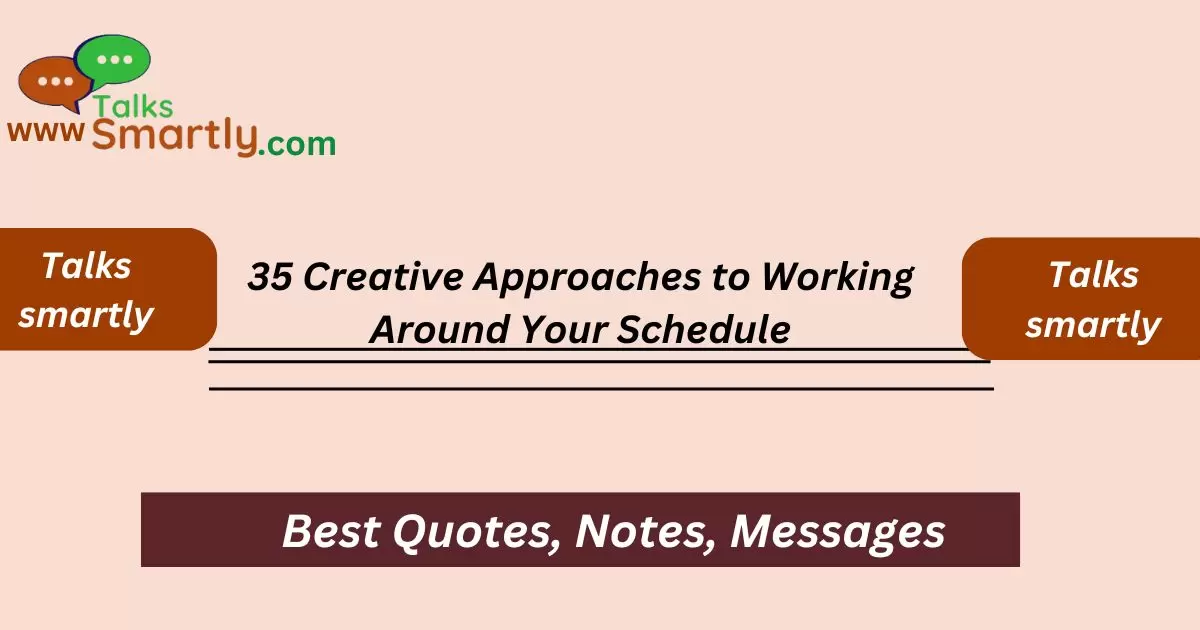“Balancing a busy schedule can be tough, but with creative strategies, you can optimize your time and reduce stress.”
Finding ways to work around a busy schedule requires more than just traditional time management techniques. It involves innovative approaches that can help you stay productive while also making time for yourself.
In this blog post, we will explore creative approaches to working around your schedule. These strategies aim to enhance productivity, flexibility, and overall well-being.
By implementing these approaches, you can better handle your commitments and create a more manageable routine.
35 Creative Approaches to Working Around Your Schedule
- Embrace Time Blocking
- Utilize the Pomodoro Technique
- Adopt a Flexible Routine
- Leverage Technology for Efficiency
- Prioritize Tasks with the Eisenhower Matrix
- Delegate Tasks When Possible
- Incorporate Buffer Times
- Use the Two-Minute Rule
- Set Clear Goals and Milestones
- Practice Mindful Scheduling
- Experiment with the 80/20 Rule
- Create a Daily Ritual
- Limit Multitasking
- Implement a Weekly Review
- Try Batch Processing
- Optimize Your Workspace
- Incorporate Breaks for Rejuvenation
- Use Visual Planning Tools
- Establish Boundaries for Work and Personal Time
- Set Priorities with ABC Method
- Adopt a ‘Just Start’ Mentality
- Apply the Seinfeld Strategy
- Embrace the Art of Saying No
- Seek Feedback and Adjust
- Incorporate Flexible Deadlines
- Utilize Quiet Hours
- Employ the ‘Single-Task’ Approach
- Engage in Regular Self-Reflection
- Involve Family and Friends
- Maintain a Healthy Work-Life Balance
- Use Productivity Apps
- Create a Contingency Plan
- Keep a Task Journal
- Incorporate Rewards and Incentives
- Stay Adaptable and Open-Minded
1. Embrace Time Blocking
Time blocking involves scheduling specific periods for different tasks or activities. It helps in allocating focused time for each task, minimizing distractions.
Example: “Block out 9-11 AM for project work and 2-3 PM for meetings.”
2. Utilize the Pomodoro Technique
This technique breaks work into 25-minute intervals, separated by short breaks. It helps maintain focus and productivity by preventing burnout.
Example: “Work on a task for 25 minutes, then take a 5-minute break.”
3. Adopt a Flexible Routine
A flexible routine allows you to adapt to changes in your schedule. It offers structure but accommodates unexpected events.
Example: “Follow a basic daily routine but adjust tasks based on current priorities.”
4. Leverage Technology for Efficiency
Use apps and tools designed to improve productivity and organization. These can automate tasks and keep track of deadlines.
Example: “Utilize task management apps like Trello or Asana to organize your projects.”
5. Prioritize Tasks with the Eisenhower Matrix
This matrix helps prioritize tasks based on urgency and importance. It divides tasks into four categories: urgent/important, important/not urgent, urgent/not important, and not urgent/not important.
Example: “Focus on tasks that are both urgent and important first.”
6. Delegate Tasks When Possible
Delegating tasks can help manage your workload more effectively. It frees up your time for more critical activities.
Example: “Assign routine tasks to team members or use outsourcing services.”
7. Incorporate Buffer Times

Buffer times are short periods between tasks to handle unexpected delays. They help maintain a smooth workflow.
Example: “Add 15-minute breaks between meetings to manage overruns.”
8. Use the Two-Minute Rule
If a task takes less than two minutes, do it immediately. It prevents small tasks from piling up and overwhelming you.
Example: “Respond to quick emails as soon as they arrive.”
9. Set Clear Goals and Milestones
Define clear, achievable goals and milestones for your tasks. It provides direction and motivation.
Example: “Set a goal to complete a project phase by the end of the week.”
10. Practice Mindful Scheduling
Mindful scheduling involves being aware of your priorities and energy levels. It helps you allocate time to tasks that align with your current state of mind.
Example: “Schedule creative tasks during your peak energy times.”
11. Experiment with the 80/20 Rule
The 80/20 Rule, or Pareto Principle, suggests that 80% of results come from 20% of efforts. Focus on the most impactful activities.
Example: “Identify and prioritize the tasks that yield the most significant outcomes.”
12. Create a Daily Ritual
Establishing a daily ritual can help start your day with purpose. It sets a positive tone and enhances productivity.
Example: “Begin each day with a short meditation or review of your top priorities.”
13. Limit Multitasking
Focusing on one task at a time often leads to better results than multitasking. It reduces mistakes and increases efficiency.
Example: “Complete one project task before moving on to another.”
14. Implement a Weekly Review
Regularly review your progress and adjust your plans as needed. It helps in staying on track and adapting to changes.
Example: “Conduct a weekly review to assess completed tasks and plan for the next week.”
15. Try Batch Processing
Batch processing involves grouping similar tasks together. It minimizes context switching and improves efficiency.
Example: “Handle all emails in one session rather than sporadically throughout the day.”
16. Optimize Your Workspace
A well-organized workspace can enhance focus and productivity. Keep your environment tidy and equipped for your tasks.
Example: “Arrange your desk to minimize distractions and keep essential tools within reach.”
17. Incorporate Breaks for Rejuvenation
Regular breaks are essential for maintaining energy and focus. Use breaks to recharge and prevent burnout.
Example: “Take a 10-minute break every hour to stretch and relax.”
18. Use Visual Planning Tools
Visual tools like calendars and planners help in organizing and tracking your schedule. They provide a clear overview of your commitments.
Example: “Use a color-coded calendar to map out your tasks and deadlines.”
19. Establish Boundaries for Work and Personal Time
Set clear boundaries between work and personal time to prevent overlap. It helps in maintaining a healthy work-life balance.
Example: “Designate specific work hours and avoid checking work emails outside these times.”
20. Set Priorities with ABC Method
The ABC Method helps in prioritizing tasks based on their importance. Assign A, B, or C to tasks to determine their priority level.
Example: “Categorize tasks as A (most important), B (important but less urgent), or C (least important).”
Best Study Locations for Optimal Focus
21. Adopt a ‘Just Start’ Mentality
Overcoming procrastination by simply starting a task can lead to progress. Often, beginning is the hardest part.
Example: “Start by tackling the first small step of a larger project to gain momentum.”
22. Apply the Seinfeld Strategy
The Seinfeld Strategy involves maintaining a streak of productive days. It uses a visual calendar to track progress and build consistency.
Example: “Mark off each day you complete a task to build a streak of productive days.”
23. Embrace the Art of Saying No
Learning to say no to non-essential tasks or commitments helps manage your schedule better. It protects your time and energy.
Example: “Politely decline additional projects that don’t align with your priorities.”
24. Seek Feedback and Adjust
Regularly seek feedback on your scheduling and productivity. Use the input to make necessary adjustments.
Example: “Ask colleagues or mentors for feedback on your time management and adjust accordingly.”
25. Incorporate Flexible Deadlines
Allowing for flexible deadlines can reduce stress and improve work quality. It accommodates unforeseen delays or changes.
Example: “Set deadlines with some flexibility to handle unexpected issues.”
26. Utilize Quiet Hours

Designate specific times for uninterrupted work. It helps in focusing deeply on tasks without distractions.
Example: “Set aside early mornings or late evenings for tasks that require concentration.”
27. Employ the ‘Single-Task’ Approach
Focus on one task at a time rather than juggling multiple tasks. It enhances concentration and efficiency.
Example: “Complete one project before starting another to ensure quality results.”
28. Engage in Regular Self-Reflection
Regularly reflect on your productivity and scheduling practices. It helps identify areas for improvement.
Example: “At the end of each week, review what worked well and what could be improved.”
29. Involve Family and Friends
Communicate with family and friends about your schedule to gain their support. It helps in managing personal commitments effectively.
Example: “Inform your family about your work hours to coordinate household responsibilities.”
30. Maintain a Healthy Work-Life Balance
Balancing work and personal life is crucial for overall well-being. Ensure you allocate time for both work and relaxation.
Example: “Schedule time for hobbies and relaxation alongside work tasks.”
31. Use Productivity Apps
Productivity apps can help streamline tasks and keep track of deadlines. They offer tools for better time management.
Example: “Try apps like Todoist or Microsoft To Do to manage your daily tasks.”
32. Create a Contingency Plan
Having a contingency plan helps manage unexpected changes or emergencies. It ensures you can adapt without disrupting your schedule.
Example: “Prepare a backup plan for critical tasks in case of unforeseen issues.”
33. Keep a Task Journal
A task journal helps track progress and reflect on your work. It provides insights into how you manage your schedule.
Example: “Maintain a journal to record daily tasks and review your accomplishments.”
34. Incorporate Rewards and Incentives
Rewarding yourself for completing tasks can boost motivation. It makes the process more enjoyable and fulfilling.
Example: “Treat yourself to something enjoyable after finishing a challenging project.”
35. Stay Adaptable and Open-Minded
Being adaptable and open to new approaches helps in managing changes effectively. It allows you to adjust your schedule as needed.
Example: “Remain flexible and open to experimenting with different scheduling methods.”
ANSWER TO KEY QUESTION
1. How can I effectively implement time blocking?
Time blocking involves setting aside specific periods for different tasks. Start by mapping out your daily schedule, allocating time slots for each task, and sticking to these time blocks.
2. What are the benefits of using the Pomodoro Technique?
The Pomodoro Technique helps improve focus and productivity by breaking work into manageable intervals. It reduces burnout and increases efficiency through regular breaks.
3. How can I balance flexibility with maintaining a routine?
Adopt a flexible routine by setting broad goals and allowing for adjustments as needed. This approach provides structure while accommodating changes in your schedule.
4. What are some effective tools for visual planning?
Visual planning tools like calendars, planners, and task management apps help organize and track your schedule. Tools like Google Calendar and Trello are popular choices.
5. How can I incorporate rewards into my schedule?
Set up a system where you reward yourself for completing tasks or reaching milestones. It can be something small like a treat or a break, making work more enjoyable.
Conclusion
Creative approaches to working around your schedule can significantly enhance productivity and reduce stress. By employing techniques like time blocking, the Pomodoro Technique, and visual planning tools.
you can better manage your time and balance your commitments. Incorporating these strategies helps create a more efficient and fulfilling routine, allowing you to achieve your goals while maintaining a healthy work-life balance.












